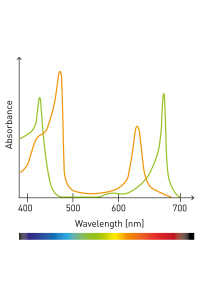UV-VIS Anti-pancreatic lipase assay
- Product Code: 31939
UV-VIS Anti-pancreatic lipase assay
UV-VIS Anti-pancreatic lipase assay (1 sample)
Measuring the inhibition of pancreatic lipase activity using UV-Vis spectrophotometry is a valuable method for evaluating compounds or substances that may have anti-pancreatic lipase properties. Pancreatic lipase is an enzyme responsible for breaking down dietary fats in the small intestine. Here's a general protocol for conducting an anti-pancreatic lipase assay using UV-Vis spectrophotometry:
Materials and Reagents:
Pancreatic lipase enzyme
Substrate solution (e.g., p-nitrophenyl butyrate)
Inhibitor substance or sample extract
Appropriate buffer solution (e.g., Tris-HCl buffer, pH 8)
Deionized water
Positive control inhibitor (optional)
Pipettes and pipette tips
Test tubes or microcentrifuge tubes
Vortex mixer or shaker
Timer or stopwatch
Lint-free tissue for cuvette cleaning
Procedure:
Prepare a Blank Solution:
Use a UV-grade quartz cuvette and fill it with the buffer solution (without any inhibitor or pancreatic lipase). This will serve as your blank reference for baseline correction.
Calibrate the Spectrophotometer:
Turn on the UV-Vis spectrophotometer and allow it to warm up.
Set the wavelength to the appropriate value for monitoring the enzymatic reaction. The exact wavelength may depend on the specific assay conditions, but it's typically around 410-420 nm for p-nitrophenyl butyrate.
Adjust the spectrophotometer's baseline using the blank solution, so that it reads zero absorbance at the chosen wavelength.
Prepare the Reaction Mixture:
In a test tube or microcentrifuge tube, mix the following components in the specified order:
A known volume of pancreatic lipase enzyme solution
A known volume of substrate solution (e.g., p-nitrophenyl butyrate)
A known volume of inhibitor substance or sample extract
Buffer solution to reach the desired total volume
Ensure that the enzyme and substrate concentrations are consistent between experiments.
Incubate the Reaction Mixture:
Incubate the reaction mixture at an appropriate temperature (typically around 37°C) for a specific amount of time. The incubation time may vary depending on the enzyme kinetics and the specific assay conditions.
Measure Absorbance:
After the incubation, take a small volume (usually 1 mL) of the reaction mixture and transfer it to a quartz cuvette.
Wipe the cuvette with a lint-free tissue to remove any fingerprints or smudges.
Place the cuvette in the spectrophotometer and record the absorbance at the chosen wavelength.
Calculate Pancreatic Lipase Inhibition Percentage:
Compare the absorbance of the sample with the inhibitor to the control sample without the inhibitor (blank)
| ขั้นตอน | ขั้นตอน | ผลลัพธ์ที่คาดหวัง | |||
|---|---|---|---|---|---|
| ไม่มีรายการที่จะแสดง | |||||
UV-VIS Anti-pancreatic lipase assay
UV-VIS Anti-pancreatic lipase assay (1 sample)
Measuring the inhibition of pancreatic lipase activity using UV-Vis spectrophotometry is a valuable method for evaluating compounds or substances that may have anti-pancreatic lipase properties. Pancreatic lipase is an enzyme responsible for breaking down dietary fats in the small intestine. Here's a general protocol for conducting an anti-pancreatic lipase assay using UV-Vis spectrophotometry:
Materials and Reagents:
Pancreatic lipase enzyme
Substrate solution (e.g., p-nitrophenyl butyrate)
Inhibitor substance or sample extract
Appropriate buffer solution (e.g., Tris-HCl buffer, pH 8)
Deionized water
Positive control inhibitor (optional)
Pipettes and pipette tips
Test tubes or microcentrifuge tubes
Vortex mixer or shaker
Timer or stopwatch
Lint-free tissue for cuvette cleaning
Procedure:
Prepare a Blank Solution:
Use a UV-grade quartz cuvette and fill it with the buffer solution (without any inhibitor or pancreatic lipase). This will serve as your blank reference for baseline correction.
Calibrate the Spectrophotometer:
Turn on the UV-Vis spectrophotometer and allow it to warm up.
Set the wavelength to the appropriate value for monitoring the enzymatic reaction. The exact wavelength may depend on the specific assay conditions, but it's typically around 410-420 nm for p-nitrophenyl butyrate.
Adjust the spectrophotometer's baseline using the blank solution, so that it reads zero absorbance at the chosen wavelength.
Prepare the Reaction Mixture:
In a test tube or microcentrifuge tube, mix the following components in the specified order:
A known volume of pancreatic lipase enzyme solution
A known volume of substrate solution (e.g., p-nitrophenyl butyrate)
A known volume of inhibitor substance or sample extract
Buffer solution to reach the desired total volume
Ensure that the enzyme and substrate concentrations are consistent between experiments.
Incubate the Reaction Mixture:
Incubate the reaction mixture at an appropriate temperature (typically around 37°C) for a specific amount of time. The incubation time may vary depending on the enzyme kinetics and the specific assay conditions.
Measure Absorbance:
After the incubation, take a small volume (usually 1 mL) of the reaction mixture and transfer it to a quartz cuvette.
Wipe the cuvette with a lint-free tissue to remove any fingerprints or smudges.
Place the cuvette in the spectrophotometer and record the absorbance at the chosen wavelength.
Calculate Pancreatic Lipase Inhibition Percentage:
Compare the absorbance of the sample with the inhibitor to the control sample without the inhibitor (blank)
| Mechanism | - |
| Appearance | - |
| Longevity | - |
| Strength | - |
| Storage | - |
| Shelf Life | - |
| Allergen(s) | - |
| Dosage (Range) | - |
| Recommended Dosage | - |
| Dosage (Per Day) | - |
| Recommended Dosage (Per Day) | - |
| Mix Method | - |
| Heat Resistance | - |
| Stable in pH range | - |
| Solubility | - |
| Product Types | - |
| INCI | - |
ตะกร้า
ไม่มีสินค้า



